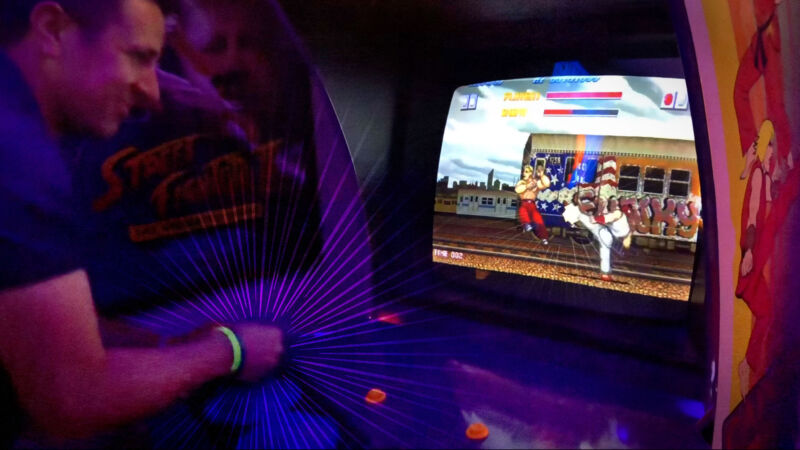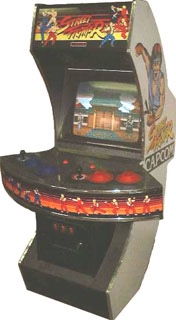

My quest to re-create Street Fighter’s long-lost pneumatic controls
source link: https://arstechnica.com/gaming/2023/03/my-quest-to-recreate-street-fighters-long-lost-pneumatic-controls/
Go to the source link to view the article. You can view the picture content, updated content and better typesetting reading experience. If the link is broken, please click the button below to view the snapshot at that time.

History! —
My quest to re-create Street Fighter’s long-lost pneumatic controls
True fighting gamers land harder hits by slamming their fists on huge "bash pads."
Vincent Pureza - 3/30/2023, 11:00 AM


As a child of the '80s who loved video games, this game intrigued me.
I soon discovered that the game was called Street Fighter (SF1), and it was made by a company called Capcom. In my local arcade, it consisted of a large, curvy cabinet with two sets of controls to accommodate two players at once. Each player had a start button, an eight-way joystick, and two large pressure-sensitive rubber buttons. This cabinet is now often called the "deluxe" or "crescent" cab, and the pressure-sensitive buttons are often called "bash pads" or "pneumatic buttons." It looked totally rad.
I recall that the controls were surprisingly stiff. Although the large pneumatic buttons looked soft, they were actually firm, and their outputs were inconsistent. And try as I might to make a super-strong killing strike, I couldn’t do it. In many ways, the game was painful to play. Maybe there was too much hype from the rumors? Maybe I should have jumped on the cabinet? Maybe there was a better way to play it?
Because of complaints of injuries to players and the high cost of maintaining the machine, Capcom eventually recalled the old pneumatic controls and helped arcade operators convert the controls to a now-familiar six-button scheme that has become the standard for many fighting games (including the game's seminal sequel, Street Fighter II).
Regardless of the control scheme, SF1 was not very fun to play for long. The special moves were too powerful, they had strict input requirements, and they were difficult to perform consistently. Despite my best efforts, most of my games degenerated into mashing buttons while making half-circle motions with the joystick and waiting for special moves to come out. (Pro tip: The game can be beaten this way even on the hardest setting.)
Advertisement The arcade game didn’t keep me or a lot of other gamers interested for long, and it soon disappeared from most arcades. There was a very cool-looking and strangely named console port, Fighting Street, but a system seller it was not. Even my wealthiest and most game-obsessed friends never bothered to buy the TG-16/PC Engine CD add-on required to play the game (although I have realized as an adult how amazing this system truly is). For me and many folks, Street Fighter was just a pretty cool game that was most useful for video game trivia.That is until Street Fighter II: The World Warrior (SF2) was released in 1991.
SF2 was amazing, and I became a huge fan of the game and its many iterations. Today, the Street Fighter franchise remains my favorite game series. Over the years, my interest in Street Fighter evolved. As a fan, I did the usual nerd stuff: joined newsgroups and forums, saw the movies and TV shows, and constructed and modded my own arcade joysticks. Eventually, I started tinkering with superguns and collecting arcade PCBs. Finally, I decided that I needed an arcade cabinet. Just one. And I knew exactly which one I wanted: the SF1 deluxe cabinet.
Overall, I knew SF1 was a mediocre game, but its deluxe cabinet was amazing. It was unique and nostalgic. It also had a large monitor and a control panel to accommodate most games I’d be interested in playing, so I began searching for an SF1 deluxe cabinet with the misguided intention of converting it into a MAME machine.
Time passed. As I searched for this cabinet, I inadvertently stepped into the arcade-collecting rabbit hole. And I fell in deep. It was fun, and working on these old games made me happy. In a way, they were time capsules, self-contained boxes full of old technology and history. I soon realized that one cabinet would not sate my curiosity. When I finally did find an SF1 deluxe cabinet, it would be the fifth cabinet I'd buy, and it was the six-button conversion. By that point, I already owned a Capcom “Big Blue” arcade cabinet, and another six-button cabinet seemed redundant. I had a solution for this little problem.
Page:
Recommend
About Joyk
Aggregate valuable and interesting links.
Joyk means Joy of geeK
